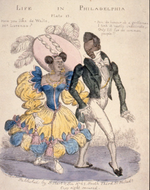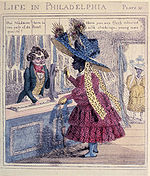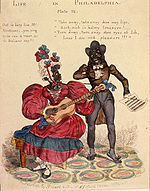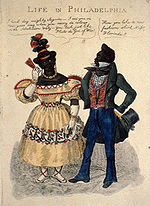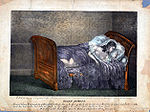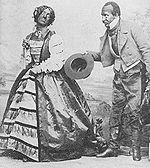More Information About Sewally and the Man-Monster Print
Introduction to: Visualizing the Man-Monster: Peter Sewally/Mary Jones, New York City, 1836
For Jonathan Ned Katz's detailed history of Peter Sewally's story see: Peter Sewally - Mary Jones, June 11, 1836
For Tavia Nyong'o's analysis of practices that conjoined blackness and whiteness in the nineteenth and twentieth centuries see his book The Amalgamation Waltz: Race, Performance, and the Ruses of Memory (University of Minnesota Press, 2009).
See also:
Addams, Charles. Dear Dead Days: A Family Album. New York: G.P. Putnam & Sons, 1959. ASIN: B000G2O7DS
Clay, E.W. Life in Philadelphia," 1829. E. W. Clay began drawing a very popular series of cartoons in 1828, after he had seen George and Robert Cruikshank's Life in London drawings while on a trip to England. Their work featured the adventures of three uninhibited young men on the town; Clay's focused on social pretensions. Between 1828 and 1830 he produced 14 aquatint engravings for the series: 4 depicted whites; 10 were caricatures of Philadelphia's free black population. The drawings were extremely popular; they were reproduced in a number of media, in more and less expensive forms, and were widely imitated by cartoonists in other cities, including New York and London. The comic image of the hyper-elegant urban black would soon become one of the two essential stereotypes of the minstrel stage. E.W. Clay, "Life in Philadelphia" Series. Philadelphia: published variously by Wm. Simpson and S. Hart, 1828-1830. Information accessed July 1, 2011 from University of Virginia website at: http://utc.iath.virginia.edu/abolitn/gallclayf.html
Clay, E.W. Clay, "Life in Philadelphia, No. 11," 1828. Aquatint cartoon, drawn and etched by E. W. Clay. Philadelphia: Published by Wm. Simpson, 1828. Caption: "Have you any flesh coloured silk stockings, young man? Oui Madame! here is von pair of de first qualite!" Courtesy of the Library Company of Philadelphia.
Clay, E.W. "Life in Philadelphia," No. 12, 1829. Aquatint cartoon, drawn and etched by E. W. Clay. Philadelphia: Published by S. Hart & Son, 1829. Caption: "Take away, take away dose rosy lips,/ Rich, rich in balmy treasure!—/ Turn away, turn away dose eyes ob lub,/ Less I die wid pleasure!!! Dat is bery fine, Mr. Mortimer, you sing quite con a moor, as de Italians say!!" Courtesy of the Library Company of Philadelphia.
Clay, E. W. "Life in Philadelphia" [unnumbered], 1828. Aquatint cartoon, drawn and etched by E. W. Clay. Philadelphia: Published by Wm. Simpson, 1828. Caption: "How do you like de new fashion shirt, Miss Florinda? I think dey mighty elegam—I see you on New Year day when you carry de colour for de Abolition 'siety—you look just like Pluto de God of War!" Courtesy of the Library Company of Philadelphia.
Cohen, Patricia Cline. The Murder of Helen Jewett: The Life and Death of a Prostitute in Nineteenth-Century New York. New YorK: Knopf, August 11, 1998. Quote: "mass produced lithographs made Jewett's image available to anyone for a modest price", page 304.
Davis, Vaginal. Blog
Gilfoyle, Timothy J. City of Eros: New York City, Prostitution, and the Commercialization of Sex, 1790-1920. New York: W. W. Norton & Company, 1992. ISBN-10: 0393028003 ISBN-13: 978-0393028003
Howard, Rollin, and George Griffin. Minstrel show performers Rollin Howard (in wench costume) and George Griffin, c. 1855. Scan from: William J. Mahar. Behind the Burnt Cork Mask: Early Blackface Minstrelsy and Antebellum American Popular Culture. University of Illinois Press December 1, 1998. ISBN-10: 9780252066962. ISBN-13: 978-0252066962. ASIN: 0252066960.
Katz, Jonathan Ned. Love Stories: Sex Between Men Before Homosexuality. Chicago: University of Chicago Press, December 2001. Hardcover: ISBN: 9780226426150, Paper ISBN: 9780226426167.
New York Historical Society. New York Divided: Slavery and the Civil War Online Exhibit. Riots Target Black New Yorkers & Abolitionists
- Map including a list of “CONTEMPLATED ATTACKS” of Saturday, July 12, 1834, compiled by the Mayor's Office, includes 108 Greene Street (Sewally's address two years later, in 1836), and says
- 108 GREEN STREET, “occupied by a Black,” the note to the mayor said, “is expected to be attacked this Evening.”
Saar, Lezley. Exhibition, including Sewally painting, at Jan Baum Gallery.
Saar, Lezley. MulattoNation.com
Robinson, Henry R. depicted in a cartoon, late 1838 or early 1839. Print titled: "LOCO FOCO PERSECUTION, OR CUSTOM HOUSE, VERSUS CARICATURES. Accessed July 6, 2011, Library of Congress: http://www.loc.gov/pictures/item/2008661320/
